Potentially harmful elements in lebanese fattoush salad
Main Article Content
Abstract
The estimation of potentially harmful element availability in Fattoush ingredients cultivated in Lebanon is essential for evaluating impending risks for human and ecosystem health. In this study and for the first time, the selected plant species were the ingredients of the traditional Lebanese salad, Fattoush, composed of lettuce, cucumber, tomato, onion, purslane, radish, lemon and sumac in order to fulfill all the requirements for the assessment of the contamination levels in vegetables from soils with potentially harmful elements. The major physicochemical properties of topsoil including pH, organic matter content and texture showed that studied soils were almost neutral pH of 7.0, very poor in organic matter (organic matter percent ˂0.05 %) and sandy respectively(based on soil texture triangle). Concentration ranges of As, Cu, Fe, Zn, Mn, Ni, V, Cd, Co, Cr, Pb, P, Sn and Al in soils and edible parts of plants collected from urban allotments in the South, Damour, Ghazir and Akkar areas were determined and assessed by Inductively Coupled Plasma Optical Emission Spectroscopy following microwave assisted digestion by HNO3/H2O2. Also, weak acetic acid digestion and aqua regia digestion were similarly measured following microwave assisted digestion. Transfer factors from sandy soils to vegetables because of their health risk were calculated accordingly. Results showed that concentrations of most of studied elements in soil and plant samples were recorded above the permissible limits set by World Health Organization especially in purslane, lemon and sumac. For this reason, amounts of accumulated Cu, Fe, Zn, Mn, Ni and V in the studied plant – soil systems (mg/kg) were separately shown. Furthermore, the sumac, purslane, lemon and lettuce plants were found to be “heavy metal hyperaccumulating plants”. Finally, soil to plant transfer is the major path way of human exposure to PHEs contamination and safety measurements should be strictly applied.
Article Details

This work is licensed under a Creative Commons Attribution-NonCommercial-NoDerivatives 4.0 International License.
References
Ariel, A. (2012). The hummus wars. Gastronomica: The Journal of Food and Culture 12:34-42.
Antoniadis, V., Papatheodorou, S. and Levizou, E. (2015). Zinc and cadmium effect in lettuce, purslane and geranium: metal transfer coefficients. Phytoremediation and Bioremediation Technologies for Removal of Heavy Metals, 1-4.
Bini, C. and Besh, J. (2014). PHEs, environment and human health. In Springer (Ed.), PHEs, environment and human health (1st edition). pp. 98-132.
Bouaoun, D. and Nabbout, R. (2016). Study of physical and chemical parameters of Oustouan river, North Lebanon. J Coast Zone Manag. 19:430.
Bouyoucos, G. J. (1962). Hydrometer method improved for making particle size analysis of soils. Agronomy Journal. 54:464-465.
Cherif, J., Mediouni, C., Ammar, W. B. and Jemal, F. (2011). Interactions of zinc and cadmium toxicity in their effects in growth and in antioxidantive systems in tomato plants (Solanium lycopersicum). Journal of Environmental Sciences. 23:837-844.
Chojnacka, K., Chojnacki, A., Gorecka, H. and Górecki, H. (2005). Bioavailability of heavy metals from polluted soils to plants. Science of the Total Environment. 337:175-182.
Demirbas, A. (2010). Oil, micronutrient and heavy metal contents of tomatoes. Food Chemistry. 118:504-507.
Fadel, D., Argyraki, A., Papageorgiou, S. and Kelepertzis, E. (2017). Heavy metals in cultivated soil and plants of Damour urban area – Lebanon. Bulletin of the Geological Society of Greece. 50:2108-2117.
Hajeb, P., Sloth, J. J., Shakibazadeh, S., Mahyudin, N. A. and Afsah-Hejri, L. (2014). Hajeb, P., Sloth, J. J., Shakibazadeh, S., Mahyudin, N. A. and Afsah-Hejri, L. Toxic Elements in Food: Occurence, Binding and Reduction Approaches. Comprehensive Reviews in Food Science and Food Safety. 13:457-472.
ISO 10390 (1994). Soil quality- determination of pH.
Khan, S., Cao, Q., Zheng, Y. M., Huang, Y. Z. and Zhu, Y. G. (2008). Health risks of heavy metals in contaminated soils and food crops irrigated with wastewater in Beijing, China. Environmental Pollution. 152:686-692.
McLaughlin M. J., Smolders E. and Degryse F. (2011). Rietra R. Uptake of metals from soil into vegetables. In: Swartjes FA, editor. Dealing with contaminated sites: from theory towards practical application. Heidelberg: Springer.
Nehme, N., Haydar, C., Koubaissy, B., Fakih, M., Awad, S., Toufaily, J. and Hamieh, T. (2014). The distribution of heavy metals in the Lower River Basin, Lebanon. Physics Procedia. 55:456-463.
Sarma, H. (2011). Metal hyperaccumulation in plants: A review focusing on phytoremediation technology. pp. 118-138.
Tueni, M., Mounayar, A. and Birlouez-Aragon, I. (2012). Development and evaluation of a photographic atlas as a tool for dietary assessment studies in Middle East cultures. Public Health Nutrition. 15:1-6.
US-EPA (2002). Methods for the determination of total organic carbon (TOC) in soils and sediments. Report No. NCEA-C- 1282, EMASC-001, Las Vegas.
Xu, L., Cao, S., Wang, J. and Lu, A. (2016). Which Factors Determine Metal Accumulation in Agricultural Soils in the Severely Human-Coupled Ecosystem. International Journal of Environmental Research and Public Health, 13:510.
Yanling, W. (1989). Jia Li (The Office of Protection for Water Resources of Huaihe River, Bengbu); Direct determination of four elements in sediments using electrothermal vaporization ICP-AES [J]. Chinese Journal of Analytical Chemistry, 12.
Zhang, M.-K., Liu, Z.-Y. and Wang, H. (2010). Use of single extraction methods to predict bioavailability of heavy metals in polluted soils to rice. Communications in Soil Science and Plant Analysis. 41:820-831.


